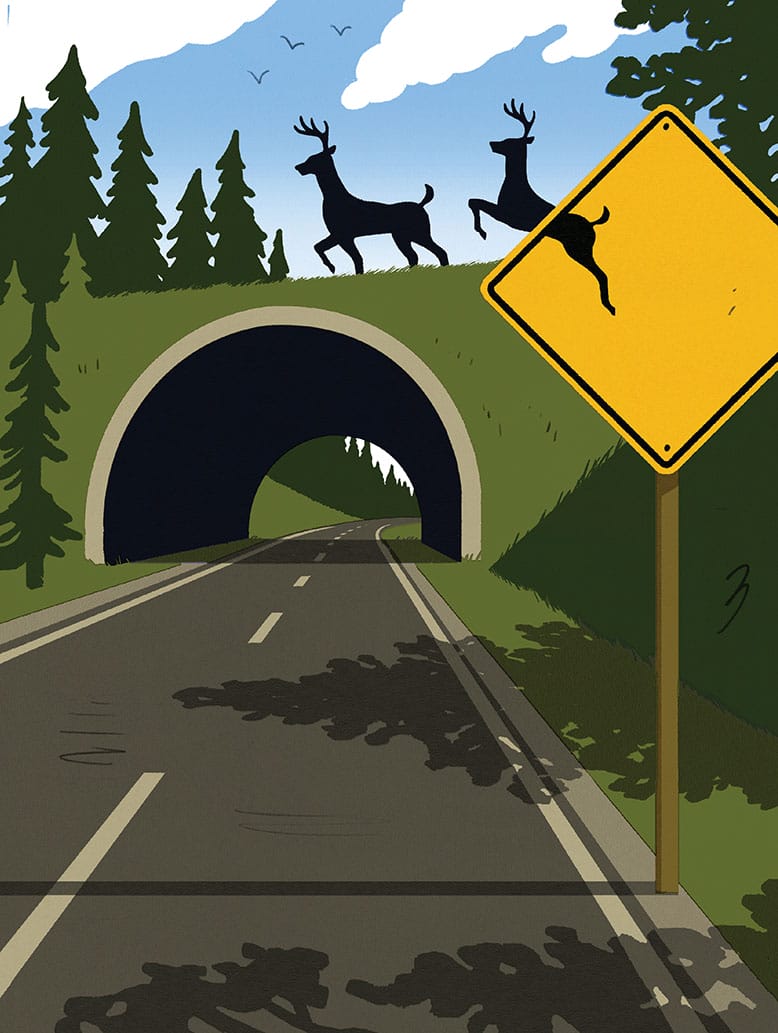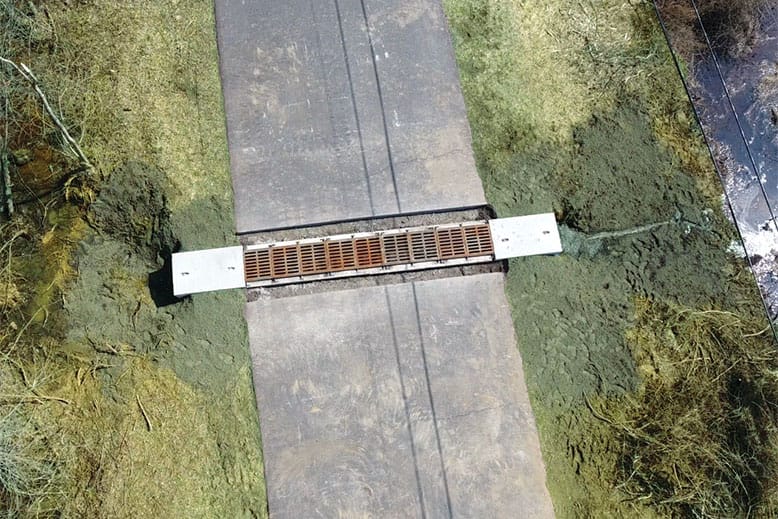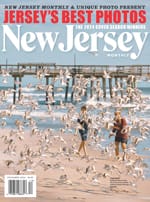
Illustration: Pete Ryan
The danger posed by wildlife crossing New Jersey’s busy roads and highways has increased enormously with the rise in animal and human populations. But a back-and-forth discussion begun years ago between state safety officials and biologists has produced a host of over-and-under solutions, using elevated walkways and tunnels.
A trio of overpasses on Route 78 in Union County and a series of underground passageways throughout Central and South Jersey are allowing creatures great and small to travel where their animal instincts dictate, without the threat of vehicular traffic. The bridges, completed in the mid-1980s inside the Watchung Reservation to facilitate unimpeded movement by deer and other large mammals, are believed to be among the first such structures in the United States built expressly for wildlife. And the tunnels, beginning in 2015 and increasing in number over the years, have allowed countless turtles, snakes and frogs, as well as raccoons and foxes, to reach their destinations unharmed.
[RELATED: How Jersey Shore Scientists Rescue Thousands of Terrapin Turtles]
“These crossings are a tool to address a much bigger issue in the state: the need to maintain habitat connectivity,” says David Golden, assistant commissioner of fish and wildlife for the New Jersey Department of Environmental Protection (DEP). “We’ve worked so hard to preserve open space, but one of the challenges is, so many of these undeveloped properties are bisected by roads. So we had to figure out how to let all this wildlife move throughout the landscape and survive.”
Golden, a DEP employee since 2000, has witnessed wildlife’s domain in constant jeopardy from steady urbanization and rising temperatures. To address the problems, the department launched a program in 2019 called Connecting Habitat Across New Jersey (CHANJ). And this past summer, citing the twin impacts of natural-lands fragmentation and climate change, environmental protection commissioner Shawn LaTourette made the issue an even higher priority, declaring June through August 2024 the “Summer of CHANJ.” The goal, LaTourette says, is “to help the public better understand the importance of habitat connectivity and to take steps, whenever possible, to support and enhance connectivity in their own communities.”
One community that has been particularly proactive about preserving its animal habitat is Bedminster (Somerset County), where a busy thoroughfare separates the north branch of the Raritan River from hundreds of acres of natural parkland. When township engineers in the mid-2010s discovered that sizable numbers of animals were being killed along River Road, they went to the drawing board, moved especially by the plight of the wood turtle, a species considered to be threatened in New Jersey. Partnering with the DEP and the New Jersey Audubon Society, Bedminster’s Department of Public Works (DPW) conceived a way to provide a safe passage for the critters, creating the state’s first wildlife tunnels. Studies have shown that as many as 150 animals per day traverse the five concrete shafts, which are topped with metal grates to let in natural light and flanked by fences that guide the animals into the 2,000-foot, mulch-bottomed tunnels on each end.
Bedminster mayor Larry Jacobs recalls that, when residents initially learned of the innovative project, “there was definitely some skepticism.” But the DPW was doing recreation area improvements, and the township ended up funding the tunnels, which came in on budget at $90,000. “I run and bike on that road all the time, and I haven’t seen a single turtle carcass,” adds Jacobs, an environmental attorney.
The expenditure was well worth it, according to the primary scientist monitoring the tunnels. Meiyin Wu, a biology professor at Montclair State University, led the study that proved their effectiveness, citing counts of raccoons and moles, as well as wood turtles, snakes, salamanders and frogs passing through them. Wu is most concerned with nonmammalian species that, like turtles, spend part of their lives in water.
“When a roadway intersects with a river or a stream, a lot of times, the people who build that road don’t realize that this waterway or the mud nearby is where many reptiles and amphibians, such as frogs and salamanders, live, and when they surface to seek drier ground in the spring, they can’t just jump over the pavement,” she says. “You end up with terrible mortality rates,” adds Wu, who serves as New Jersey’s liaison for the North Atlantic Aquatic Connectivity Collaborative, a network of academics, nonprofit environmentalists and government officials across a 13-state region stretching from Maine to West Virginia.

A wildlife tunnel at the NJDEP’s Assunpink Wildlife Management Area, which connects wetlands on either side of the road to allow wildlife to cross under the road rather than over it. Photo: Courtesy of NJDEP’s Fish & Wildlife Program
The success of the Bedminster project spurred the DEP to devise a similar setup in 2019 at the Assunpink Wildlife Management Area (WMA) in western Monmouth County. The trio of tunnels in Upper Freehold Township include one stream culvert that was widened to accommodate the addition of a dry shelf allowing wildlife to cross Route 539, and two more brand-new underground corridors linking the drainage channels on either side of the road. As with the Bedminster tunnels, fencing at each end steers the animals away from the pavement above and toward the lifesaving passageways.
The tunnels in the Assunpink, in particular, are wide enough for small- to medium-sized mammals to traverse. But an hour north of the nearly 6,400-acre WMA and a dozen-plus feet above the ground, a host of larger animals, including New Jersey’s ubiquitous white-tailed deer, owe their safety to a trio of corridors earmarked expressly for wildlife. In the mid-1980s, a plan to link I-78 from the Holland Tunnel in Lower Manhattan to Lebanon County in Pennsylvania was delayed due to environmental-impact concerns that arose over proposed construction of the highway through the Watchung Reservation. I-78 was ultimately moved to the northern edge of the reservation rather than bisecting the 2,000-acre parcel.
To preserve habitat connectivity, the state Department of Transportation (NJDOT) built the overpasses, which the New Jersey DEP says may have been among the very first of their kind in the United States at the time. One, created solely for wildlife, was vegetated and remains heavily used by deer, whose scat (or droppings) has been observed there frequently, says Lizzy Galamba, an NJDOT spokeswoman. Two were designed for shared use between drivers and wildlife, which travel on green space separated from the roadway by a barrier. The longer of those shared-use corridors, commanding 260 feet of Glenside Avenue above the highway, remains open to traffic in both directions. The other, on Nike Site Road near the long-defunct missile base, is today only for fauna; gates prohibiting vehicles were erected many years ago, according to NJDOT.
The DEP does not track animal crossings on these three overpasses, but it is presumed that, given their proximity to diverse habitat, they serve a wide variety of wildlife, notes Caryn Shinske, a senior press officer for the DEP. This wildlife ranges from the tiniest insects to foxes and skunks to elk and moose, as well as deer. While these Reagan-era structures paved the way for countless animals to avoid grisly deaths, subsequent research has fine-tuned scientists’ understanding of the importance of maintaining connected habitat for all creatures.
For the last few decades, Howard Reinert, a biology professor at the College of New Jersey, has been studying the timber rattlesnake, which the New Jersey DEP considers one of the state’s most endangered species. Homing in on a few isolated populations in the Pine Barrens, Reinert and his wife, geneticist Lauretta Bushar, have found a clear correlation between the number of roads connecting populations and the extent of variation seen in the populations. “If these snakes literally can’t cross the road, no matter how close they are in distance, then populations can’t reach each other to breed,” Reinert explains. “Over time, they undergo a loss of the genetic diversity necessary to evolve and fight disease. So eliminating these barriers is essential to the health of the species.”
Across New Jersey, impediments have been eliminated in a few other areas with critical needs for tunneling under highways and streets, coupled with fewer roadblocks to securing construction permits. The DEP required five more culverts in the Pine Barrens at Medford Lakes (Burlington County) and a sixth in another Pines location, near New Jersey Air National Guard’s Warren Grove Gunnery Range on the Ocean/Burlington county border. The department also has plans for an amphibian passage system in Byram Township (Sussex County), where a 1,200-foot section of Waterloo Road near Allamuchy Mountain State Park is prohibiting animals from reaching their vernal breeding ponds. Construction of the four-tunnel system is slated to begin in 2025, says Golden. “We’d love to build more of these, but there are challenges,” he adds. “In many cases, we face a hurdle with the entity that owns the road, whether that’s another state agency, a county, a municipality or a private landowner, to get permission to do the work.”
When the work is complete, it does more than just help the species for which it was intended. In Bedminster, the man who was mayor when the state’s original tunnels were built marveled recently at the effect they have had on more than a few human residents. “You drive over these grates and think they’re just speed bumps, but people walking nearby occasionally stop and peer in and want to learn about them,” says Steve Parker, who was mayor from 2013 to 2018. “And the ones who remember when we put them in as part of our outdoor recreation plan associate them with an appreciation for nature. Through that journey, we all developed a greater awareness of wildlife.”
[RELATED: Bonsal Wildlife Preserve a Hidden Gem in NJ]
Pamela Weber-Leaf, a nonpracticing environmental lawyer, has covered the environment beat at two daily newspapers.
No one knows New Jersey like we do. Sign up for one of our free newsletters here. Want a print magazine mailed to you? Purchase an issue from our online store.



